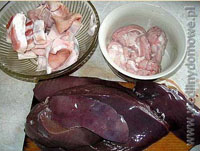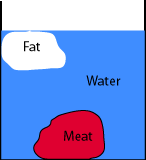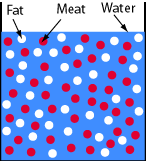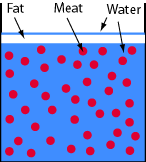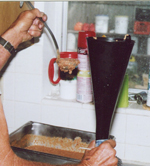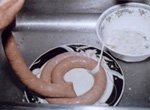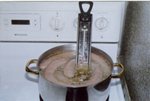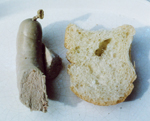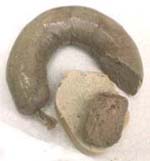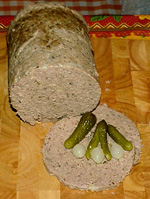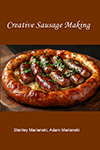Meats and Sausages
Liver Sausages
Liver sausages are quite easy to make, and they taste delicious. Although they require an additional processing step, such as meat pre-cooking, all labor is done within the kitchen's boundaries of the kitchen making it easy and enjoyable. In most cases, the smoking process is eliminated.
Liver sausages can be classified as:
- Regular liver sausages - coarsely comminuted through 5 mm (1/4 inch) grinder plate and cooked in water.
- Delicatessen type liver sausages - finely comminuted through 2-3 mm (1/8 inch) grinder plate and emulsified.
- Pâtés - liver sausages that are not stuffed but placed in molds and baked or cooked in water. Molds are often lined with pastry, and pâtés are covered with decorations and gelatin.
Composition of a Liver Sausage

The liver is an organ that works hard by filtering blood a,nd as an animal grows older, the liver becomes darker and might develop a slightly bitter taste. Think of it as it were a filter that would become dirtier in time, the difference is that not the dust, but atoms of heavier materials like iron or copper will accumulate in time within its structure.
Calf is slaughtered at the age of 4 months, a pig at 6 months, but a cow may live a few years. Because it is older, the cow’s liver or blood is of darker and will induce a darker color to a finished sausage. On the other hand, veal, pork, or poultry liver will make a sausage lighter and will make it taste better. This does not mean that you can not use beef liver, and up to 25% of beef liver may be mixed with other livers without compromising the final taste. As the name implies, a liver is an essential ingredient in the recipe, but which one is the best?
| Liver source | Description |
|---|---|
| Veal | Excellent. Light color, great taste, more expensive. |
| Pork | Very good. |
| Lamb and goat | Suitable. Up to 50% can be mixed with pork liver. |
| Beef | Can be mixed with other livers but should not account for more than 25% of the total liver mass. Dark color. |
| Goose | Very good. |
| Chicken, turkey, duck | Good. Can be mixed with pork liver in any proportions. |
| Rabbit | Very good. Can be mixed with pork liver in any proportions. |
| Venison and wild game | Poor. |
As you can see you can control the quality and color of your sausage by choosing the type of liver used. The way you will process liver, fat and meats will have the biggest impact on the quality of your sausage and the selected spices will add the final touch. Best liver sausages are made from livers of young animals. Up to 25% of beef can be added as it is tougher and will darken liver sausage. Poultry such as goose, duck or turkey will make a fine liver sausage, but chicken liver is not the best choice.
Liver must NOT be cooked. In many recipes liver is cooked briefly (blanched) in hot water for up to 5 min to remove any leftover blood but there is no real need for that. Blanching will cook some of the liver proteins and less of them would be available for emulsifying fat and water. Instead, liver can be rinsed and soaked in cold water for one hour to get rid of any traces of blood and remaining gall liquid. Soaking liver in milk is an old remedy for the removal of some of the liver’s bitterness which can be noticeable in beef liver.
Meat Selection For Liver Sausages
Meats used for commercially made liver sausages are first cured with sodium nitrite to obtain a pinkish color and the characteristic cured meat flavor. Liver sausages made at home are seldom cured, so the color of the sausage will be light greyish or yellow. That will largely depend on the type of liver and spices used.
It is advantageous, especially when making coarse-type liver sausage, to use meats with a lot of connective tissues, such as pork head meat, jowls (cheeks), or skin. Those parts contain a lot of collagen, which turns into gelatin during heat treatment. During subsequent cooling, the gelatin solidifies, becoming a gel, and that makes the sausage spreadable with a rich mouthful texture. Meats commonly used in commercial production are pork head meat, jowls, meat trimmings, and skin. Although pork head meat may not appeal to most people as valuable meat, it is high in fat and connective tissues and contains more meat flavor than other cuts. For those reasons it is a perfect meat in liver or head cheese production.
If skinless pork jowls or skinless head meat is used about 5-10% of skins are added. Keep in mind that too many skins may make the texture of your sausage feel rubbery. As long as the proper proportion of liver and fat is observed, the remaining meats can be of any kind: pork, beef, or veal.
Fat
Liver sausages contain a large percentage of fat (20-40%) which largely determines their texture and spreadability. If pork fat is used it makes no big difference whether a hard fat (back fat), soft fat (belly), or other fat trimmings are utilized. Beef fat or pork flare fat (kidney) are not commonly used as they are hard and not easy to emulsify.
To make fine spreadable liver sausage, fat should be dispersed in the liquid state at warm temperatures. To achieve a final chopping temperature of around 95° F, (35° C), fat or fat trimming is usually poached at 176° F (80° C). Then, when still warm, they are ground. Liver and lean meat are emulsified at cool (or room) temperature. Then, warm ground fats are mixed with liver, lean meat and spices together.
Salt, Spices and Other Ingredients
Liver sausages contain less salt than other sausages, the average being 12-18 g (1.2-1.8%) of salt per 1 kg of meat. Those sausages are of a much lighter color, thus white pepper is predominantly used, Home made style liver sausages and pâtés are usually made without sodium nitrite, so the final color remains greyish in sharp contrast to pinkish commercial products. Sodium nitrite has some effect on extending the shelf life of the product and for that reason alone, it is used by commercial processors.
Most liver sausages are not smoked, so there is no need to use nitrite. If a smoked flavor is desired, sodium nitrite is usually added, then the sausage is lightly smoked with cold smoke. Liver sausages are cold smoked after being cooked in hot water. The purpose of smoke is to impart a flavor only; smoking does not affect the preservation of the product, which happens to be highly perishable.
Fresh onions are frequently used in homemade liver sausages but are a poor choice in canned products and can create a sour taste. Milk or sweet cream is often added fo a milder taste. Like in other sausages, sugar may be added to offset the salty taste. Vanilla is often added to create an aromatic sweet taste. Nutmeg, mace, allspice, marjoram, white pepper, sweet paprika, and ginger are commonly used spices. Port or brandy are often added.
Home Production Of Liver Sausages
Precooking meat. Commercial plants cure meats with sodium nitrite regardless whether they will be smoked or not. Liver sausages made at home contain meats that are traditionally not cured although if a smoked product is desired, sodium nitrite should be added. Pork skin should be clean without any remaining hair or excess fat. They are cooked at 85º-90º C (185-194º F) in a separate vessel as much longer cooking time is needed. If the skins are undercooked, they will be hard to emulsify, and hard pieces may be visible in a finished sausage. If overcooked, they will break into pieces. When the skins are properly cooked they should hold their shape but you should be able to put your finger through them.
Pork heads are normally cut in halves and cooked at 85-90º C (185-194º F) until all meat and fat can be removed by hand. If they fall off the bones by themselves, the pork head is overcooked. All cartilage and gristles must also be removed. If pork head meat will not be used the same day it should be frozen. If jowls come attached to the head, they must be removed and cooked separately as different times are involved. Fats and other meats are cooked at 85-90º C (185-194º F) until internal meat temperature reaches 70º C (158º F). Don’t discard leftover meat stock, it can be added to meat mass during emulsifying or grinding (about 0.1 liter - 0.2 liter, or 1/2 cup) per 1 kg of meat.
Grinding. Warm pre-cooked meat should be minced with a small grinder plate 3-5 mm (1/8-3/16”). The liver is ground cold. The ground liver is easily emulsified as it contains a lot of water and blood. Grinding of meats, especially liver with a small plate, increases the surface area and improves spreadability.
Emulsifying. To achieve a fine texture, ingredients that compose a liver sausage are cut in a bowl cutter which requires crushed ice or cold water. As raw liver is a natural emulsifier, this task is greatly simplified. During the comminution process the fat cells become ruptured and the free fat is released. Fat does not dissolve in water or mix with it well. The purpose of emulsion is to bond free fat, meat and water together.
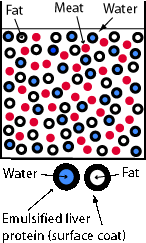
Emulsified liver protein acts as an emulsifier. It encapsulates particles of fat and water with a thin emulsion coat which binds them together preventing their separation. Thus the quality of liver sausage depends on this emulsification process and liver should account for about 25-30% of the total meat mass.
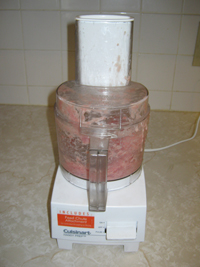
Meats that were previously ground are emulsified in a kitchen food processor until a smooth paste is obtained. Liver is emulsified separately until air bubbles appear on the surface. Even if meat and fat are ground only, at least emulsifying the liver is a good idea. If no food processor is available, grind meats and liver twice or three times through the fine grinder plate.
Natural emulsifiers that help to emulsify sausages are egg protein, blood plasma, soy and sodium caseinate. According to the 2018 USDA National Nutrient Database, one large egg contains 6.3 g of protein distributed between the yolk and white portions (3.6 g in egg white and 2.7 g in egg yolk). Commercial plants use chemical emulsifiers such as monoglycerides and diglycerides. If emulsification is not done right, the finished product might display pockets of fat. Experienced sausage makers massage cooked and still warm sausages between their thumb and index fingers to prevent that. The sausage will have a more delicate texture and will be more spreadable if grinding is followed by emulsifying.
Mixing. Meat, fat and liver are mixed together with salt and spices. Between 10-20% meat stock may be added now. This can be performed in a food processor.
Stuffing. Meat mass should be warm (35-40º C, 95-104º F) and not too dense. The casings are filled rather loose. Beef middles or natural hog casings are often used, synthetic waterproof casings can be used as well but will not allow smoke to go through. It is impractical to Using a manual grinder with a stuffing tube to stuff casings is awkward as the sausage mass is soupy. A practical solution is to attach a casing to a funnel and pour the sausage mass from a large cup or fill the funnel with a ladle. Due to its weight, the sausage mass will fall down by itself into the casing and no pushing is required. This way, one continuous coil of loosely filled sausage can quickly be made and then subdivided into individual links or rings.
Times between grinding/emulsifying, mixing and stuffing should be kept to the minimum. Longer delays will lower the temperature of the sausage mass considerably, which should stay at least at 35º C (95º F) as fat particles start clumping together below this temperature. That prevents them from being properly coated by emulsified liver protein and increases the risk of fat separation during the cooking process. Another reason for keeping short processing times is that a warm sausage mass surface area is high in moisture and sugar (liver may contain up to 8% of glycogen, which is a kind of glucose sugar) that makes a perfect breeding ground for bacteria. If pre-cooked meats are to be processed at a later date, they should be frozen. Then they should be thawed and re-heated in hot water before going into the grinder. Fresh or chilled liver tastes better than a previously frozen one.
Cooking
Better quality sausages are cooked in the stock that has been obtained during the cooking of meats. The cooking temperature must stay below the boiling point, usually about 176º F (80º C), otherwise, casings might burst open. After a while, the layer of fat would accumulate on the surface of the stock. It is a good idea to remove this fat when using stock for cooking sausages. The reason is that the top sausages may burst open due to the fat’s higher temperature than that of water. Cooking water absorbs meat flavor and is usually saved for making soup.
Cooling
,Sausages are usually rinsed with tap water and then placed in cold water. Then they are spread on the table to cool. Finely comminuted liver sausage may be gently massaged between the thumb and index finger. This will prevent the possibility of accumulating pockets of fat inside of the sausage. When the sausages are cool, they are placed in a refrigerator.
Smoking
Once the sausages have cooled down to 30º C (86º F), they are sometimes submitted to a short (30 min) cold smoking process (20 - 30º C, 68 - 86º F) to impart the generally liked smoky flavor to a product. This will also provide an additional degree of preservation on the surface of the sausage against bacteria. In addition, the sausage develops a light golden color. After smoking, sausages must be placed in a refrigerator.
Storing
Liver sausages should be kept at the lowest temperatures above the freezing point possible: 0 - 2º C (32 - 34º F), although in a home refrigerator, temperatures of about 3 - 4º C (38 - 40º F) can be expected.
Notes
People who object to eating pork for religious reasons can still make liver sausages utilizing poultry and beef livers and replacing pork fat with oil. The rules of the game remain the same: to make a quality sausage you need liver, fat (oil), meat and spices. There is no need to worry about fat particles clumping together at below 35º C (95º F) as oil will remain in its liquid state.
Beef tripe is white in color and tripe stews are popular in many countries: “flaczki” in Poland or “Sopa de Mondongo” in any Spanish-speaking country. Although tripe has practically no meat- binding nor water-holding properties, it is a nutritious material. About 10% cooked and finely ground beef tripe can be added to liver sausage. As the tripe is white, The sausage will develop a lighter color as the tripe is white.
Pâtés (French for “pie”) may be considered a type of liver product whose composition resembles a liver sausage, but the product is baked in the oven (“pâtè”) or placed in molds what becomes a “terrine.” Frequently duck and venison meats are used. Very often those molds are inserted in a bigger dish filled with water and then baked. Some are placed in molds lined up with pastry and the pastry lid is placed on top. Often, gelatin and decorative fruits are added; brandy or port wine are also incorporated. As they are not stuffed in casings, we don’t consider them to be sausages. For those interested in learning more, the best advice is to get a good cookbook that will cover the subject of “charcuterie”.
Foie Gras (in French “fat liver”) is made only with 80% of goose or duck liver with no other meats added.

